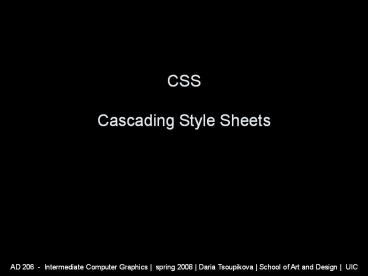CSS Cascading Style Sheets - PowerPoint PPT Presentation
Title:
CSS Cascading Style Sheets
Description:
CSS Cascading Style Sheets – PowerPoint PPT presentation
Number of Views:399
Avg rating:3.0/5.0
Title: CSS Cascading Style Sheets
1
CSSCascading Style Sheets
2
- CSS
- Define style, look and presentation of the
website content - The way the content is presented on the page is
- determined in presentation rules in a style sheet
- layout
- background
- fonts
- margins
3
- CSS
- HTML
- is used to create logical structure of the
content - CSS
- is used to style the structured content
4
- Styles
- External
- reside in a separate style sheet file (.css)
- Internal
- located inside individual page within ltstylegt
tags inside the documents ltheadgt - Inline
- located within HTML tags themselves and only
apply to the content of that tag
5
- Style rules Cascade
- There are rules to determine which style takes
- precedence while multiple styles can cover a
single - element of the page.
- When style rules conflict, the laws of
- the cascade determine how the conflict is
settled. - The order of the cascade
- 1. External
- 2. Internal
- 3. Inline
6
- Style rules Cascade
- The closer a rule to the element getting styled,
the more power the rule has in the battle of
conflicting style rules. - The order of the cascade
- 1. External
- 2. Internal
- 3. Inline
7
- Creating CSS
- A style rule begins with a selector.
- Selector can be a
- tag
- class
- id
8
- Creating a style rule for a tag
- Redefining the style for a tag gives considerable
control, - as HTML has a tag for nearly any type of text you
need to - format.
- ltbodygt
9
- DW CSS categories
- Type
- Background
- Block
- Box
- Border
- List
- Positioning
- Extensions
10
- Creating a Custom class
- Style rule for something that does not have tag
as - a label.
- Custom name for a style when you create a class.
- .myclass
- Do not create classes for something that has a
logical tag, like heading lth1, h2, h3, etcgtYou
can simply redefine one of the heading tags. - HTML is used to create logical structure of the
content - CSS used to style the structured content
11
- Creating a Custom class
- Class is reusable
- Many different elements on a page can be assigned
to the - same class
- Class has a name
- A period (.) precedes a class selector
- Named elements can be targeted with CSS rules
12
- Creating a Custom class
- Class style rule must be applied to the
- document
13
- Creating advanced selectors (IDs, pseudo-class
- selectors)
- An ID can only be used once per page
- IDs are unique
- Used in addition to CSS rules
- A hash or pound sign () precedes an id selector.
- subnav
14
- Creating advanced selectors (IDs, pseudo-class
- selectors)
- ID is another method for assigning names
- ID style rule must be applied to the
- document
15
- Pseudo-class selectors
- Names so because pseudo-states dont actually
exist in - the document
- The user must do something to trigger the
pseudo-class, - such as
- Visit a link
- Hover over a link
- Browse over a visited link
16
- Pseudo-class selectors L-V-H-A order
- LoVeHAte
- A link
- A visited
- A hover
- A active
17
- Verification of styles
- Previewing in a variety of browsers and browser
versions - Sometimes the style rules conflict and you get
enexpected - results
18
- CSS for layout
- Box model
- DIV
- division
19
- CSS for layout
- Box model
- Margin
- Border
- Padding
- Content
- CSS set rules
- For each element
20
- CSS for layout
- Position and float
- Static
- Relative
- Inherit
- Absolute
- Fixed
21
- CSS for layout
- Position and float
- Static
- Relative
- Inherit
- Absolute
- Fixed
22
- CSS for layout
- Float
- Left
- Right
- None
- Inherit
23
- CSS for layout
- Elements in HTML can nest.
- Inside the body tag might be a div (division)
named - content with a div named newitem nested inside.
- Each of these nested elements exist in a
parent-child - relationship that allows CSS properties to be
inherited. - The child elements are descendants of the parent
and - inherit properties from them.






























